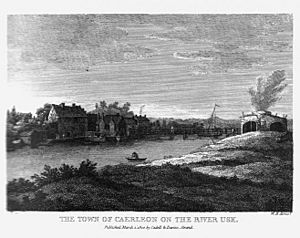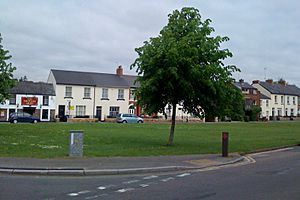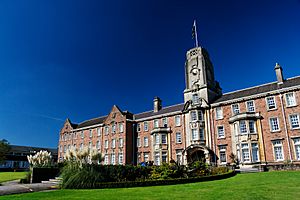Caerleon facts for kids
Quick facts for kids Caerleon
|
|
|---|---|
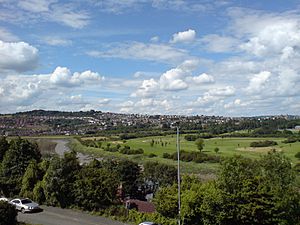 Caerleon from St Julians, Newport |
|
| Area | 9.03 sq mi (23.4 km2) |
| Population | 8,061 |
| • Density | 893/sq mi (345/km2) |
| Demonym | Caerleonite |
| Language | English Welsh |
| OS grid reference | ST336909 |
| • Cardiff | 13 mi (21 km) westwards |
| • London | 122 mi (196 km) eastwards |
| Community | |
| Principal area | |
| Ceremonial county | |
| Country | Wales |
| Sovereign state | United Kingdom |
| Post town | NEWPORT |
| Postcode district | NP18 |
| Dialling code | 01633 |
| Ambulance | Welsh |
| EU Parliament | Wales |
| UK Parliament |
|
| Welsh Assembly |
|
| Website | newport.gov.uk |
Caerleon (Welsh: Caerllion) is a town in Wales, located on the River Usk. It's about 5 miles (8 km) northeast of Newport, Wales. Caerleon is very important for its history, especially because of a famous Roman army camp called Isca Augusta. There was also an Iron Age hillfort nearby.
Today, you can visit the National Roman Legion Museum and the Roman Baths Museum in Caerleon. The town also has links to famous stories. For example, Geoffrey of Monmouth wrote about Caerleon as a major British city around 1136. Also, Alfred, Lord Tennyson wrote his famous poems Idylls of the King while staying here.
History
Roman Fortress: Isca Augusta
Caerleon is a very important place for archaeologists because it was once a large Roman army base, or castra. From about 75 AD to 300 AD, it was the main base for the Legio II Augusta (Second Augustan Legion). On a hill above the fort, there was also an Iron Age hillfort.
The Romans called the site Isca, named after the River Usk. The name Caerleon might come from the Welsh words meaning "fortress of the legion". Around 800 AD, it was known as Cair Legeion guar Uisc.
You can still see many Roman ruins today. These include the military amphitheatre, the thermae (baths), and the barracks where the Roman soldiers lived. In 2011, parts of a Roman harbour were also found in Caerleon. Some old writings suggest that Caerleon was where two early Christians, Julius and Aaron, became martyrs. Recent discoveries show that Romans might have stayed in the area until about 380 AD.
Middle Ages
During the Middle Ages, Caerleon was an important centre for the Kingdom of Gwent. The local church, St Cadoc's, was built around the 6th century on the site of the old Roman army headquarters.
A Norman-style motte and bailey castle was built near the old Roman fort. This was probably done by a Welsh lord named Caradog ap Gruffydd. The castle and town were often fought over between the Welsh and the Normans.
Caerleon was a busy market town and port. In 1171, a Welsh lord named Iorwerth ab Owain and his sons destroyed the town and burned the castle. Later, in 1217, William Marshal took control and rebuilt Caerleon castle using stone. Many old Roman buildings were probably taken apart to use their stones for the new castle.
Welsh Revolt
During the Welsh Revolt in 1402, Rhys Gethin, a general for Owain Glyndŵr, captured Caerleon Castle. This was likely the last time the castle was ruined. Even so, its walls were still standing in 1537. The castle ruins finally fell apart in 1739. Today, the most visible part of the old castle is the Round Tower, which is part of The Hanbury Arms pub. It is a Grade II* listed building, meaning it's a very important historic building.
English Civil War
Across the Afon Lwyd river from Caerleon, near Penrhos Farm, there are two forts from the English Civil War. In 1648, Oliver Cromwell's soldiers camped on Christchurch Hill before attacking Newport Castle the next day.
18th and 19th Centuries
The old wooden bridge in Caerleon was destroyed in a storm in 1779. The stone bridge you see today was built in the early 1800s. Before the Victorian docks were built in Newport Docks, Caerleon was the main port on the River Usk.
Factories for making tinplate and other mills were built near the town around this time. Caerleon grew so much that it almost joined up with Newport.
A plaque on the Mynde wall in High Street mentions the Newport Rising of 1839. This was an important event in the Chartist movement, which fought for workers' rights. John Jenkins, who owned Mynde House and the tinplate factory, built the wall to keep demonstrators out.
The name of the old Drovers' Arms pub on Goldcroft Common reminds us of the ancient drovers' road that passed through here. This common might have once been a place where cattle were bought and sold.
Mari Lwyd
In 1951, a local historian named Fred Hando described a traditional event in Caerleon called the Mari Lwyd. This tradition involved a person dressed with a horse's skull. The skull's jaw could move using rods. Hando's friend said the Mari Lwyd hadn't been seen in the town for at least 20 years, but he remembered it well: "We filled the eye-holes with wadding and 'pop alleys' and fixed great ears made of wadding stiffened with cardboard; then we stuck rosettes on the sides of the skull and strung long coloured ribbons as reins."
One person led the Mari, holding the ribbons. The Mari itself was covered in a white sheet. Three singers followed, singing in Welsh, even though they didn't understand the words. Sometimes, the Mari Lwyd procession would start far north and travel through the town, ending as far south as Goldcliff. The group would be invited into houses along the way and given money, homemade cakes, and drinks.
Another description from 1841 talks about this Yuletide tradition: "The custom of singing at their neighbours' doors on the Twelfth Night... they are dressed up with ribbons of different colours. One person carries a horse's head decorated in the same way. Pictures of trees with apples and oranges are also carried, and on one branch, an artificial bird called "Aderyn Pica Llwyd" (the grey hobgoblin bird) is placed."
Arthurian Legend
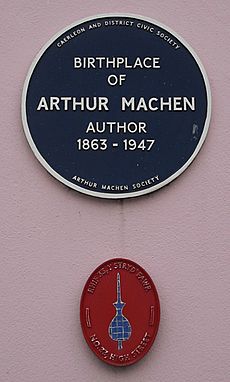
In his book Itinerarium Cambriae (1191), Gerald of Wales wrote about Caerleon. He said that "the Roman ambassadors here received their audience at the court of the great king Arthur."
Geoffrey of Monmouth, who was the first to write a lot about King Arthur, made Caerleon one of the most important cities in Britain in his book Historia Regum Britanniæ. He wrote that it had a long, glorious history. He even said it became a very important church centre, with an Archbishopric that was more important than Canterbury and York.
Geoffrey said that Arthur's capital city was Caerleon. Even Thomas Malory wrote that Arthur was crowned there again. The Roman amphitheatre in Caerleon, which you can still see, has been linked to Arthur's 'Round Table'. Some people think it might even be where the legend of the Round Table came from.
Geoffrey described Caerleon like this: "For it was located in a delightful spot in Glamorgan, on the River Usk, not far from the Severn Sea. It had more wealth than other cities and was perfect for such a ceremony. The noble river I have named flows along one side, where kings and princes from overseas could arrive by ship. On the other side, protected by meadows and woods, it was amazing for its royal palaces, which looked like Rome with their golden roofs... Famous for so many pleasant features, Caerleon was made ready for the announced feast." (from Historia Regum Britanniae)
The large size of the ruins and Caerleon's importance in the early Middle Ages might have inspired Geoffrey. However, the main historical link between Arthur and "the camp of the legion" comes from a list of Arthur's twelve battles in a 9th-century book called Historia Brittonum. But the "urbs legionis" (city of the legion) mentioned there could also be Chester or even York. The name "Camelot" first appears in a story by Chrétien de Troyes, though he also mentions Caerleon.
Modern Caerleon
Overview
Caerleon is built around a small shared green space called Goldcroft Common. This is the only one left of Caerleon's seven commons. Most of the town's small shops are near the common, as is the Town Hall. The Town Hall has a memorial garden for those who fought in World War I and World War II. The Caerleon library is inside the Town Hall. The main crossroads of High Street and Cross Street is known as The Square.
Important buildings include Saint Cadoc's Church, the National Roman Legion Museum, the Roman Baths Museum, The Mynde, The Priory Hotel, and Caerleon Endowed School. The Round Tower and the Toll House at Caerleon Bridge are also notable. There are 86 listed buildings in Caerleon, meaning they are protected for their historical importance.
The old Roman Legionary Fortress, Isca Augusta, is very popular with tourists and school groups. There's a special heritage trail in the town to explore it. The Millennium Wildlife Garden is a small nature garden by the River Usk. From Christchurch Hill, you can see amazing views of the Vale of Usk and the Bristol Channel.
Caerleon has playing fields at Broadway and a children's playground on Cold Bath Road. The Celtic Manor Resort nearby offers private sports and leisure facilities. There are several restaurants, cafés, and pubs in Caerleon that serve food. The Ffwrrwm is a unique shopping area with interesting sculptures.
Governance
Caerleon is an electoral ward (a local voting area) of Newport City Council. This ward includes Christchurch and Bulmore. Caerleon is part of the Newport West area for the UK Parliament. It's also in the Newport West area for the Senedd (Welsh Parliament).
Geography
The centre of Caerleon is in the Usk Valley. The River Usk forms part of the town's southern border. In the northwest, the land rises steeply to Lodge Wood, where there's an old hill fort. The western edge of the town is along the A4042 road. The northern border is partly along Malthouse Road and partly along the Afon Lwyd river, which flows south to the River Usk on the town's eastern side. Across the River Usk, to the southeast and east, are St Julian's Park, the village of Christchurch, and the area around Christchurch Hill.
Transportation
Road Caerleon is about 3.5 miles (5.6 km) from Newport city centre and 5.5 miles (8.9 km) from Cwmbran. It's also about 2 miles (3.2 km) north of the M4 motorway. The B4596 (Caerleon Road) connects Newport city centre to Caerleon, crossing Caerleon Bridge. The B4236 (Ponthir Road) links Caerleon to Cwmbran. The Usk Road connects Caerleon to Usk.
There's a regular bus service that connects Caerleon to Newport city centre and Cwmbran. A special open-top bus service runs in the summer. A path for bikes and walkers runs alongside the River Usk, connecting Caerleon to Malpas and Newport city centre. This path is part of the National Cycle Network (Route 88).
Rail Trains travel through Caerleon on the Welsh Marches Line, but they don't stop at the old Caerleon railway station, which is now closed. The closest train stations for passengers are Newport railway station and Cwmbran railway station.
Transport for Wales has said that Caerleon might get a new train station in the future as part of the South Wales Metro project.
Education
Most education in Caerleon is in English. However, all schools in Wales must teach some Welsh language. There are no Welsh-speaking schools in Caerleon itself, but there are three primary schools elsewhere in Newport that teach in Welsh. The nearest Welsh-speaking secondary school is Ysgol Gyfun Gwynllyw in Pontypool.
Primary Schools The primary schools in Caerleon are Charles Williams Church in Wales Primary School and Lodge Hill Primary School. Charles Williams is one of the largest Church Primary Schools in Wales.
Secondary Education
Caerleon Comprehensive School provides secondary education for students in the area.
Higher Education
Caerleon used to have a campus of the University of South Wales. This campus closed on July 31, 2016. It was once the main campus of the University of Wales, Newport and the second largest campus of the University of South Wales after universities merged in 2013. It offered many courses, including education, sports, and photography. The campus had good sports facilities, a library, and student housing.
In 2014, the University of South Wales announced the Caerleon campus would close in 2016. The university planned to sell the land for new houses. However, many local people were against this plan. The Caerleon Civic Society asked Cadw, which protects historic buildings in Wales, to give the main Edwardian building a Grade II Listed building status. This would help save it from being torn down. In August 2016, the Welsh Government agreed to recommend listing the main building and other parts as "buildings of special architectural and historic interest." The university was still against this, but local politicians and the Civic Society were happy. The Grade II listing was confirmed on March 3, 2017.
Housing
Historically, most houses in Caerleon were on the west side of the River Usk, between Caerleon Bridge and Caerleon Common. There were only a few houses on the east side. In recent years, many new housing areas have been built to the west of Caerleon. These include Lodge Hill, Home Farm, Roman Reach, Trinity View, Brooklea, and The Brades. New houses in nearby Ponthir and Cwmbran have also made traffic in Caerleon busier.
Pubs and Restaurants
Caerleon has long been known for its nightlife and places to eat. Many coaching inns opened here in the early 1800s. Today, there are thirteen pubs, bars, or restaurants, including:
- The Priory (an Abbey was first built here in 1179)
- Olde Bull Inn (from the 15th Century)
- The Hanbury Arms (from 1565)
- The Bell (originally built as a chapel in 1814)
- The White Hart (a hotel that became a pub in 1815)
Sport
Caerleon has been part of several sporting events.
Newport Half Marathon
The Newport Half Marathon race route goes through Caerleon. Runners enter the town on the National Cycle Route 88 path, pass the Roman Amphitheatre, cross Caerleon Bridge, and then head back towards Newport city centre.
Tour de Gwent
On July 8, 2018, the Velothon Wales cycling event included Caerleon. It had routes of different lengths. In 2019, it was announced that Velothon Wales would stop. Instead, the Tour de Gwent became the main cycling event for South Wales each year. It has a 93-mile route and other distances for different skill levels. It starts in Caerleon, goes to Abergavenny, and returns to Caerleon.
Tour of Britain 2017-2018
Caerleon has hosted the British national cycling race, the Tour of Britain, twice, in 2017 and 2018. Famous international riders like Julian Alaphilippe and Geraint Thomas have raced on the popular routes here. Belmont Hill, with its steep climb, is a favourite spot for the race organizers.
On September 10, 2017, the Tour of Britain came to Caerleon as part of its route from Worcester to Cardiff. There was an exciting moment when riders Gorka Izagirre and Mark Stewart broke away from the main group over Belmont Hill. This hill is a tough climb with a 9% average slope. The stage was won by Edvald Boasson Hagen.
On September 2, 2018, Caerleon again hosted the Tour of Britain. This stage went from Pembrey to Newport. Welsh Tour de France champion Geraint Thomas, who grew up nearby, raced in this event. The stage was won by André Greipel. The race organizers sent riders from Newport city centre to Caerleon using the National Cycle Route 88, which is mostly flat along the Usk riverside. The route passed the Roman fortress and then went into the countryside around the Celtic Manor Resort, and then to Usk. The "King of the Mountains" climb was again at Belmont Hill. Geraint Thomas famously said the climb was "too steep" after he lost his lead to climber Alaphilippe.
2010 Ryder Cup
The local golf club was used in promotions for the 2010 Ryder Cup, a major golf tournament held at the nearby Celtic Manor Resort.
Caerleon Golf Club is owned by the Celtic Manor Resort. It's a 9-hole golf course with a driving range and clubhouse. In winter, the golf course can flood because it's next to the River Usk.
Other Sports
Caerleon Bowls Club has a good outdoor green. It recently became the home of the Newport Athletic Bowls Club.
The football club Caerleon A.F.C. is based in Caerleon. There are also two rugby union clubs: Newport High School Old Boys RFC and Caerleon RFC. Both rugby clubs have many junior teams, and Caerleon Junior Youth Football Club is a large junior football club.
Bulmore Lido, an outdoor swimming pool with a cafe and restaurant, opened in Caerleon in July 1934. It closed in the 1980s. Newport Racecourse held the Welsh Grand National horse race in 1948, but it was the only time the race was held there. After the course closed, the race moved to Chepstow.
Culture and Community
Caerleon Arts Festival
Caerleon has hosted an arts festival every July since 2003. It started to welcome artists and sculptors from around the world. Many of the large sculptures stay in Caerleon, forming a Sculpture park and becoming local landmarks. The arts festival happens at the same time as a Roman military re-enactment in the amphitheatre. This show demonstrates Roman armour, fighting styles, cavalry, equipment, and siege engines like ballistae.
The festival has grown to include a literary festival, food and drink, and a "Big Free Weekend" of entertainment and visual arts. Events are held in places like the open-air Roman amphitheatre, which hosts plays in the summer.
Other Events
- A detailed history of Caerleon was published in 1970 by local historian Primrose Hockey. She was a founder of the Caerleon Local History Society. Her collection of local history is kept at the Gwent Record Office.
- St Cadoc's Hospital in Caerleon has been used as a filming location for BBC television shows like Doctor Who and Being Human.
Images for kids
-
Plaque at birthplace of Arthur Machen, The Square, High Street
See also
 In Spanish: Caerleon para niños
In Spanish: Caerleon para niños






